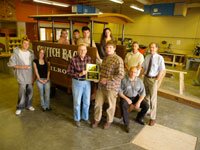|
|||||||||||
Exposure to elements has decayed 15-year old landmark replicaAL ZAGOFSKY/TIMES NEWS Carbon Career and Technical Institute's carpentry class receives Switchback passenger car replica that has been outdoors at Mauch Chunk Lake Park for 15 years and is in near of renovation. The replica is of the style used on the line between 1842 and 1872. The Switchback passenger car replica that has stood as a landmark at the entrance to Mauch Chunk Creek Park has been removed from its tracks and taken to the Carbon Career and Technical Institute for reconditioning. The car, one of two built by Switchback Gravity Railroad Foundation president Levio Grosso about 15 years ago, has been parked on a 200-foot track just south of the main park entrance, at the juncture of the original 1827 downtrack and the 1842 realignment. The right-of-way of the realigned tracks forms a trail the park uses for hiking, biking and cross-country skiing. The 15-year exposure to sun, rain, humidity and insects has caused significant rotting to exposed wood and particularly in the crevices where wooden pieces overlap. A new roof is also required. The replica car was removed from its tracks onto a sliding bed truck provided by Loars Towing of Lansford. The move was managed by John Drury - executive director of the Switchback Gravity Railroad Foundation and taken to the carpentry shop class at CCTI. After the class decides what is required for the renovation, they will provide a list to the Foundation, who will provide materials. The Switchback, originally known as the Mauch Chunk Railroad, was constructed to link the anthracite coal mines in Summit Hill to the Lehigh River at Mauch Chunk, current Jim Thorpe. It was the first railroad in Pennsylvania and the first coal railroad in America. Although there were railroads built before it in America, they only ran for a short time. The Switchback ran for over a century-from 1827 to 1933. It was originally designed as a coal railroad, but from its first day of operation, it took a select number of passengers for a ride that would reach speeds of over 40 mph. The empty cars returned up the mountain, pulled by a team of mules. In 1842, the Lehigh Coal and Navigation Company, owner of the Switchback, added two inclined planes with Engine Houses at the top, to create a Backtrack. The Backtrack functioned like a roller coaster by raising the cars to the tops of Mount Pisgah and Mount Jefferson before they were released to descend by gravity. The Switchback car being renovated is a replica of the car used during the period from 1842 to the time coal operations were ceased in 1872. During this period, coal was transported in the morning and passengers enjoyed scenic pleasure rides in the afternoon. After 1872, the Switchback became a scenic passenger rail solely, and transformed Mauch Chunk into the second most popular tourist destination in America. The line closed in 1933, after competition from the automobile, closing of local access roads, and the onset of the Depression significantly decreased ridership. What remained of the Switchback was sold for scrap in 1937. Local historians formed the Foundation to attempt to rebuild the line. After exploring the possibilities and finding too many impediments, the Foundation refocused its efforts and is currently in the process of a Feasibility Study to determine if the summit of Mt. Pisgah, which contains remains of the Engine House and lookouts, can be preserved as a park. CCTI enjoys helping with community service projects. It helps the students meet community service requirements, it helps the non-profits, and the students learn about local history and historic restoration. |
|||||||||||
